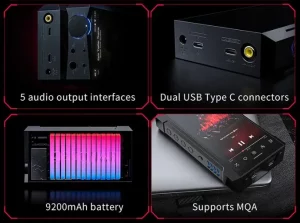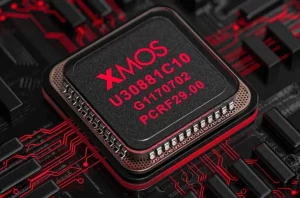
The FiiO M17 is a big DAP with an enormous sound. It can be most likely one of the vital full transportable audio gadgets I've reviewed thus far. Both headphone and IEM customers will discover the M17 has the skill and the sheer grunt to fulfill each. DC Mode is a pure pleasure to make use of for demanding planar headphones particularly.
Overview of FiiO M17
Despite this evaluation being about five pages long and over 10ok phrases, I'm penning this opening line final as a result of a nightmare beginning to any street journey. I've most likely left the proverbial iron on when hitting publish. you can also like
Shanling M9
In brief, the brand new flagship FiiO M17 DAP is so feature-rich that I'm certain I've missed one thing you could be interested in. Apologies upfront then if I've; however, do, please remark beneath if there's something you shortly need to find out about.

Warning, this DAP is not an M15 on steroids or a disguised Pro model. This is one thing new. FiiO has thrown the proverbial R'n'D kitchen sink on the M17 to supply a participant that's not that far off the kitchen sink's dimensions but also fairly presumably one of the vital superior delta-sigma DAPs available on the market right this moment.
The new M17 uses a reasonably hefty high-end delta-sigma-based twin ES9038PRO implementation with an FPGA-controlled 'digital bridge.' These are desktop-grade chips relatively more than the cell Q2M model, and while being out for some time now, they're nonetheless thought-about ESS's flagship chipset.
Features of FiiO M17
Because they're desktop-grade and 8-channel versus the 2-channel cell variations, this can be an extra power-hungry setup. So, it isn't stunning to see a reasonably hefty 9200mAh battery contained in the M17 with 8V rails (11V for the analog circuit utilizing the DC energy provided) and a single opamp for every channel's I/V stage.

The preliminary digital sign entry is dealt with by an XMOS XUF208 and a twin DK Femtosecond crystal oscillator for time management earlier than being despatched to the principle DAC contained in the M17. I presume the Femtosecond crystal oscillators will target 44.1 kHz and 48 kHz, whereas the XMOS XUF208 management chip will allow and help native DSD 512 enter.

The M17 presents a wide variety of decoding parameters, although most pattern charges will rely on whether or not you go for native playback or through its USB-DAC.
For native playback, it's capped at 384kHz-32bit/DSD256, which is great; however not the prime tier for me. Via the M17's USB-DAC, the XMOS XUF208 is aggressive, providing you with the most 768kHz-32bit/DSD512 for decoding.
One slight shock is the MQA functionality of the FiiO M17, which is capped at 8X as an alternative of 16X supplied by among the competitors. That means upsampling 48kHz containers might be a most of 384kHz as an alternative of 768kHz. How related that might be to you as a person won't be so vital because the vast majority of high-res music usually tops out at 96ok or 192ok for now.

The M17 additionally marks FiiO's change to a more modern Qualcomm QCC5124 BT receiver from the M15's older CSR8675 SoC. The customary continues to be BT5.0, identical because of the M15. Nevertheless, the decoding means is far stronger now than the earlier flagship. Both supplied LDAC and aptX HD in receiving mode; however, now the M17 can deal with aptX LL and aptX Adaptive.
Other features
In some methods, the amplification design of the FiiO M17 is the true star of the present. However, it's a barely extra complicated affair than your common DAP or transportable media participant with two distinct strategies of driving headgear: through the battery and DC Mode.
At the guts of the M17's impartial amplifier circuitry is a THX 788+ providing each balanced and single-ended output. THX class amplifiers have been the default of various FiiO DAPs not too long ago, akin to M11 Pus LTD, reviewed by James.

However, the earlier implementation has been very much a transportable class THX, specifically the THX AAA-78. This time,
FiiO partnered with THX to develop a wholly new amplification opamp referred to as the THX788+, a unique spin on their 788 chipsets utilized in desktop amplifiers.
Compared to the unique 788 spec sheet, the brand new 788+ model is highly effective and presents an extra IEM-friendly decrease output impedance score for SE output at under 1Ω. Going balanced, the impedance score is just a little excessive for me for IEMs with a <2Ω score; however shouldn't currently be any points for many headphones.
https://mdshariful.com/product/fiio-m17/?feed_id=3454&_unique_id=636647da474ae
 The FiiO M17 is a big DAP with an enormous sound. It can be most likely one of the vital full transportable audio gadgets I've reviewed thus far. Both headphone and IEM customers will discover the M17 has the skill and the sheer grunt to fulfill each. DC Mode is a pure pleasure to make use of for demanding planar headphones particularly.
The FiiO M17 is a big DAP with an enormous sound. It can be most likely one of the vital full transportable audio gadgets I've reviewed thus far. Both headphone and IEM customers will discover the M17 has the skill and the sheer grunt to fulfill each. DC Mode is a pure pleasure to make use of for demanding planar headphones particularly.
 Warning, this DAP is not an M15 on steroids or a disguised Pro model. This is one thing new. FiiO has thrown the proverbial R'n'D kitchen sink on the M17 to supply a participant that's not that far off the kitchen sink's dimensions but also fairly presumably one of the vital superior delta-sigma DAPs available on the market right this moment.
The new M17 uses a reasonably hefty high-end delta-sigma-based twin ES9038PRO implementation with an FPGA-controlled 'digital bridge.' These are desktop-grade chips relatively more than the cell Q2M model, and while being out for some time now, they're nonetheless thought-about ESS's flagship chipset.
Warning, this DAP is not an M15 on steroids or a disguised Pro model. This is one thing new. FiiO has thrown the proverbial R'n'D kitchen sink on the M17 to supply a participant that's not that far off the kitchen sink's dimensions but also fairly presumably one of the vital superior delta-sigma DAPs available on the market right this moment.
The new M17 uses a reasonably hefty high-end delta-sigma-based twin ES9038PRO implementation with an FPGA-controlled 'digital bridge.' These are desktop-grade chips relatively more than the cell Q2M model, and while being out for some time now, they're nonetheless thought-about ESS's flagship chipset.
 The preliminary digital sign entry is dealt with by an XMOS XUF208 and a twin DK Femtosecond crystal oscillator for time management earlier than being despatched to the principle DAC contained in the M17. I presume the Femtosecond crystal oscillators will target 44.1 kHz and 48 kHz, whereas the XMOS XUF208 management chip will allow and help native DSD 512 enter.
The preliminary digital sign entry is dealt with by an XMOS XUF208 and a twin DK Femtosecond crystal oscillator for time management earlier than being despatched to the principle DAC contained in the M17. I presume the Femtosecond crystal oscillators will target 44.1 kHz and 48 kHz, whereas the XMOS XUF208 management chip will allow and help native DSD 512 enter.
 The M17 presents a wide variety of decoding parameters, although most pattern charges will rely on whether or not you go for native playback or through its USB-DAC.
For native playback, it's capped at 384kHz-32bit/DSD256, which is great; however not the prime tier for me. Via the M17's USB-DAC, the XMOS XUF208 is aggressive, providing you with the most 768kHz-32bit/DSD512 for decoding.
One slight shock is the MQA functionality of the FiiO M17, which is capped at 8X as an alternative of 16X supplied by among the competitors. That means upsampling 48kHz containers might be a most of 384kHz as an alternative of 768kHz. How related that might be to you as a person won't be so vital because the vast majority of high-res music usually tops out at 96ok or 192ok for now.
The M17 presents a wide variety of decoding parameters, although most pattern charges will rely on whether or not you go for native playback or through its USB-DAC.
For native playback, it's capped at 384kHz-32bit/DSD256, which is great; however not the prime tier for me. Via the M17's USB-DAC, the XMOS XUF208 is aggressive, providing you with the most 768kHz-32bit/DSD512 for decoding.
One slight shock is the MQA functionality of the FiiO M17, which is capped at 8X as an alternative of 16X supplied by among the competitors. That means upsampling 48kHz containers might be a most of 384kHz as an alternative of 768kHz. How related that might be to you as a person won't be so vital because the vast majority of high-res music usually tops out at 96ok or 192ok for now.
 The M17 additionally marks FiiO's change to a more modern Qualcomm QCC5124 BT receiver from the M15's older CSR8675 SoC. The customary continues to be BT5.0, identical because of the M15. Nevertheless, the decoding means is far stronger now than the earlier flagship. Both supplied LDAC and aptX HD in receiving mode; however, now the M17 can deal with aptX LL and aptX Adaptive.
The M17 additionally marks FiiO's change to a more modern Qualcomm QCC5124 BT receiver from the M15's older CSR8675 SoC. The customary continues to be BT5.0, identical because of the M15. Nevertheless, the decoding means is far stronger now than the earlier flagship. Both supplied LDAC and aptX HD in receiving mode; however, now the M17 can deal with aptX LL and aptX Adaptive.
 However, the earlier implementation has been very much a transportable class THX, specifically the THX AAA-78. This time, FiiO partnered with THX to develop a wholly new amplification opamp referred to as the THX788+, a unique spin on their 788 chipsets utilized in desktop amplifiers.
Compared to the unique 788 spec sheet, the brand new 788+ model is highly effective and presents an extra IEM-friendly decrease output impedance score for SE output at under 1Ω. Going balanced, the impedance score is just a little excessive for me for IEMs with a <2Ω score; however shouldn't currently be any points for many headphones.
https://mdshariful.com/product/fiio-m17/?feed_id=3454&_unique_id=636647da474ae
However, the earlier implementation has been very much a transportable class THX, specifically the THX AAA-78. This time, FiiO partnered with THX to develop a wholly new amplification opamp referred to as the THX788+, a unique spin on their 788 chipsets utilized in desktop amplifiers.
Compared to the unique 788 spec sheet, the brand new 788+ model is highly effective and presents an extra IEM-friendly decrease output impedance score for SE output at under 1Ω. Going balanced, the impedance score is just a little excessive for me for IEMs with a <2Ω score; however shouldn't currently be any points for many headphones.
https://mdshariful.com/product/fiio-m17/?feed_id=3454&_unique_id=636647da474ae


No comments